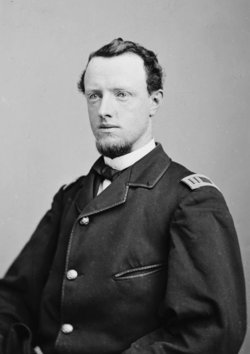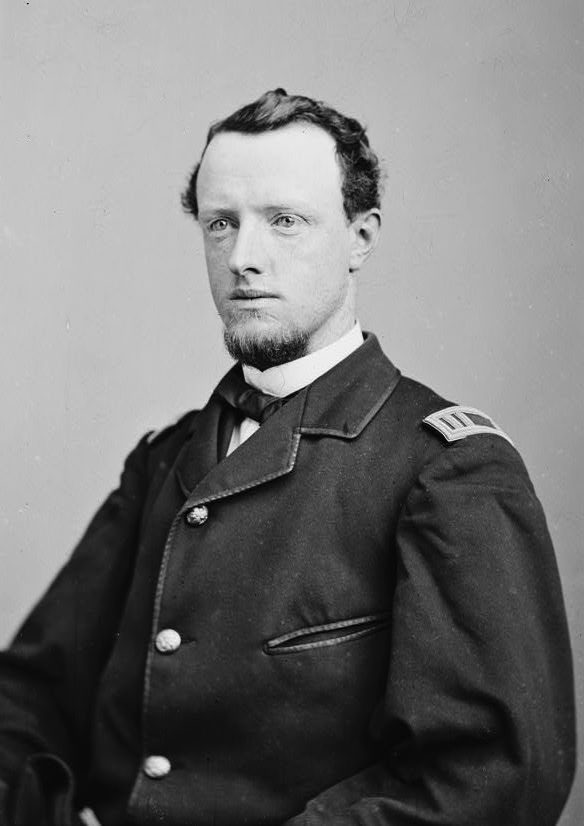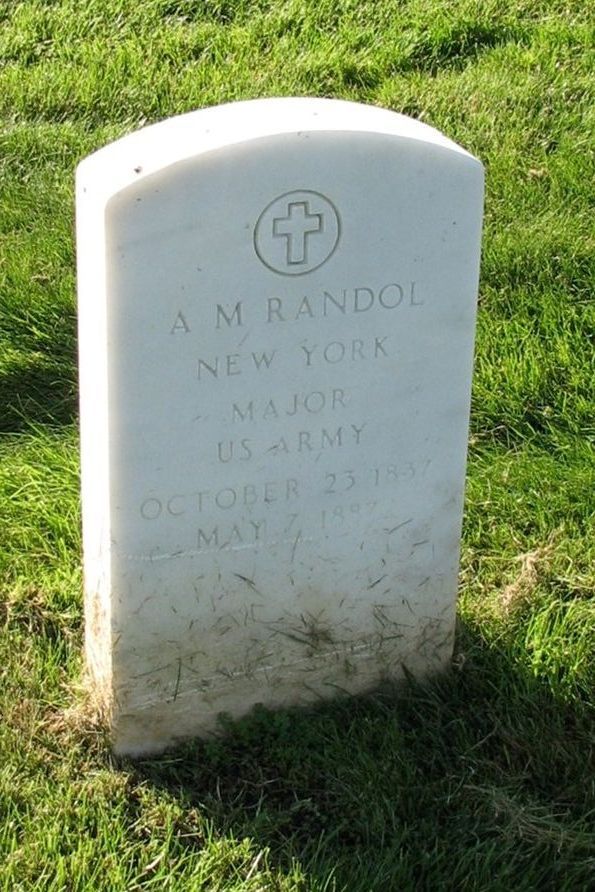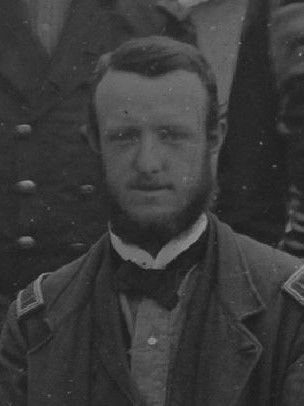Alanson Merwin Randol was born in Newburgh, New York, the son of Alanson, Sr. and Mary Butterworth Randol. He attended private boarding school in Connecticut during his youth and was admitted as a cadet to the United States Military Academy at West Point, New York in 1855. He graduated with the USMA Class of 1860, academically ranked ninth of forty-one cadets, commissioned a second lieutenant with the 1st U.S. Artillery Regiment posted at Benicia Arsenal, California until the outbreak of the American Civil War in 1861.
In May 1861, following the Confederate attack on Fort Sumter in Charleston Harbor, South Carolina, Randol was promoted to first lieutenant of Battery E, 1st U.S. Artillery, one of the batteries present during the siege of that fort; he was ordered east to Washington, D.C. from California to join his new company, while en route he served with state volunteer Battery L, 1st Missouri Light Artillery in the service of Major General John Fremont's Department of the West on detached service between August and December 1861.
Randol joined his new company in the artillery defenses of Washington, D.C. in January 1862; in the absence of commanding officer Captain Jefferson Columbus Davis (on detached service in the Western Theater for the duration of the war), Randol assumed command of Battery E, a position he held through October 1863. Shortly after his arrival, Battery E was temporarily merged with Battery G, 1st U.S. Artillery, forming Battery E & G, 1st U.S. Artillery (known in the official records colloquially as "Randol's Battery" through 1863).
Randol's Battery E & G joined the artillery reserve of Major General George McClellan's Army of the Potomac during the Peninsula Campaign of 1862, present at the siege of Yorktown and later held in reserve through the Seven Days Battles of June 1862.
Randol is perhaps best remembered for his service at the Battle of Glendale in June 1862. Following the Union defeat at the Battle of Gaines' Mill, when McClellan ordered his Army of the Potomac to retreat south from the Chickahominy River to the banks of the James River at Malvern Hill, Lieutenant Randol's battery was detached from the artillery reserve for temporary service with the Second Brigade, Third Division of the Union V Corps under Brigadier General George Archibald McCall, which was tasked with securing and holding the junction of the New Market and Quaker Roads near the small community of Glendale, west of Richmond, Virginia, while the Army of the Potomac was nearby in transit to the south. On June 30, 1862, General Robert E. Lee's Army of Northern Virginia attacked in strength at the Glendale crossroads in an attempt to bisect the Union Army of the Potomac while it passed; the Union line held, thanks in no small part to Randol's artillerists, but the line was broken at Randol's position by Confederate Brigadier General Cadmus Wilcox's brigade, and his guns were overtaken and captured. With the help of his commanding officer, Second Brigade commander Brigadier General George Gordon Meade (of Gettysburg fame), Randol was able to briefly retake his guns during a famously intense hand-to-hand struggle, but the defensive position was untenable due to the emergence of two fresh Confederate brigades on his flank, and by sundown he had to abandon his six artillery pieces to the enemy and retreat with the remnant of his company to safety at Malvern Hill. For his stubborn defense, Randol won a brevet promotion to the rank of captain for gallant action at Glendale.
Without his battery, Brevet Captain Randol assisted Army of the Potomac Artillery Reserve commanding officer Colonel Henry Jackson Hunt throughout the Union victory at the Battle of Malvern Hill, briefly commandeering a New York volunteer battery of howitzers (Battery D, 1st New York Light Artillery) then in disarray near the end of the fight; in July 1862, Randol's own Battery E & G was soon rearmed, and with it he participated in the battles of Second Bull Run, Antietam, and Fredericksburg before the end of 1862. He was promoted to the rank of Regular Army captain in October 1862, assigned to command of Battery H, 1st U.S., though he remained on detached service at the head of his old Battery E & G, attached to the Third Division, V Corps, as divisional chief of artillery.
Following the Union defeat at the Battle of Chancellorsville in May 1863, in which he was also hotly engaged near United States Ford, Randol joined the cadre of commanders of the elite United States Army Horse Artillery Brigade when his Battery E & G was outfitted as a horse artillery battery. Equipped with light 3-inch Ordnance rifles and detached to service with the Army of the Potomac's Cavalry Corps, his battery participated in the Gettysburg Campaign in pursuit of Lee's Confederate army into Pennsylvania. Battery E & G was present at the Battle of Gettysburg, engaging General J.E.B. Stuart's rebel cavalry in the "east cavalry field" on the extreme right flank of the Union line at approximately the same time as Pickett's Charge on the third day of the fighting. Randol earned a brevet promotion to the rank of major for his actions at Gettysburg.
Randol finally joined his own command, Battery H , 1st U.S., in September 1863, in time for the Bristoe and Mine Run Campaigns; he was soon thereafter transferred to Battery I, 1st U.S., and he trained and equipped the latter company as a horse artillery battery. The two companies were merged into Battery H & I, 1st U.S. in April 1864, and in May 1864 joined General Ulysses Grant's Overland Campaign, engaged at the battles of the Wilderness, Spotsylvania Courthouse, and Cold Harbor; the battery sustained much loss along the campaign.
In August 1864, Randol was detailed to the United States Military Academy at West Point as an assistant professor of artillery tactics and mathematics. During this time, he successfully lobbied for command of a New York state volunteer unit. which he had coveted since 1862; in December 1864, Randol accepted the colonelcy of the 2nd New York Volunteer Cavalry Regiment and joined his new command in time to participate in the Appomattox Campaign of March 1865 under the command of Brigadier General George Armstrong Custer's division of Sheridan's Army of the Shenandoah. Randol was engaged at the battles of Five Forks and Appomattox Station, and present at Appomattox Courthouse during General Lee's surrender to General Grant in April 1865, in the personal company of Custer and close enough to the building to observe the rebel commander approaching and leaving the building during the armistice proceedings and salute him.
At the war's end, Randol was awarded Regular Army brevet promotions to the ranks of lieutenant colonel and colonel, with a corresponding United States Volunteers brevet promotion to the rank of brigadier general for his service with the 2nd New York Cavalry.
Following his mustering-out of volunteer service, Randol resumed his Regular Army rank of captain in command of Battery I, 1st U.S.: with the battery, he was assigned to Fort Brown, Texas from 1865 until 1869; at Fort Trumbull, Connecticut from 1869 until 1870; at Fort Delaware, Delaware in 1870; Fort Wood, New York from 1870 until 1872, and; at Fort Hamilton, New York in 1872.
In April 1872, Randol was transferred to command of Battery K, 1st U.S.: with the battery, he was assigned to Fort Wood, New York in 1872, and; at the Citadel in Charleston, South Carolina from 1872 until 1873.
In July 1873, Randol was transferred to command of Battery L, 1st U.S.; he was with the battery, assigned to Fort Barrancas, Florida from 1873 until 1875; at Fort Independence, Massachusetts from 1875 until 1879 (during which time he was deployed to suppress rioters in Pennsylvania during the railroad riots of 1877); at Fort Warren, Massachusetts from 1879 until 1881, and; ordered to the Pacific coast, at Fort Winfield Scott, California from 1881 until 1882.
In April 1882, Randol was promoted to the rank of major with the 3rd U.S. Artillery, but was soon returned with rank of major with his old 1st U.S. Artillery at Fort Winfield Scott in May 1882. He remained at the Presidio of San Francisco through 1884, and was the commanding officer of Fort Alcatraz, California from 1884 until 1886. In late 1886, he was briefly commanding officer of Fort Canby, Washington Territory before returning to California for the sake of his health.
In late 1886, Major Randol began to suffer the effects of advanced kidney disease, then known as Bright's disease, first noticed and diagnosed by the post surgeon upon his arrival at Fort Canby. He had a documented history of exposure to yellow fever and spent much of his career in the American South, then a hotbed of seasonal epidemics, so his particular illness was regrettably not uncommon among his brother officers. In November 1886, Randol left Fort Canby on medical leave for his brother's home at New Almaden, California; there his health gradually declined, and he finally succumbed to his illness in May 1887. He was buried with full military honors in the national cemetery at San Francisco, California.
Upon examining the career trajectory of similar officers of Randol's relative rank, experience, and academy education, had he lived longer it is not unreasonable to predict Randol would have likely achieved Regular Army general officer rank (brigadier general or higher) by his mandatory retirement at the age of 62 in 1899, especially had he participated in the Spanish-American War, as so many others of his generation did.
Randol married Elizabeth "Lizzie" Beck Guion, daughter of U.S. Army chaplain Elijah Guion, in 1869 at Brownsville, Texas. They had nine children together, only four of whom survived to adulthood, including Brigadier General Marshall Guion Randol, U.S. Army.
Randol's legacy as a noted artillerist and volunteer cavalry officer was recognized posthumously in 1904, when a United States Coast Artillery Corps seacoast artillery battery at Fort Worden in Port Townsend, Washington was named "Battery Alanson Randol" in his honor.
Alanson Merwin Randol was born in Newburgh, New York, the son of Alanson, Sr. and Mary Butterworth Randol. He attended private boarding school in Connecticut during his youth and was admitted as a cadet to the United States Military Academy at West Point, New York in 1855. He graduated with the USMA Class of 1860, academically ranked ninth of forty-one cadets, commissioned a second lieutenant with the 1st U.S. Artillery Regiment posted at Benicia Arsenal, California until the outbreak of the American Civil War in 1861.
In May 1861, following the Confederate attack on Fort Sumter in Charleston Harbor, South Carolina, Randol was promoted to first lieutenant of Battery E, 1st U.S. Artillery, one of the batteries present during the siege of that fort; he was ordered east to Washington, D.C. from California to join his new company, while en route he served with state volunteer Battery L, 1st Missouri Light Artillery in the service of Major General John Fremont's Department of the West on detached service between August and December 1861.
Randol joined his new company in the artillery defenses of Washington, D.C. in January 1862; in the absence of commanding officer Captain Jefferson Columbus Davis (on detached service in the Western Theater for the duration of the war), Randol assumed command of Battery E, a position he held through October 1863. Shortly after his arrival, Battery E was temporarily merged with Battery G, 1st U.S. Artillery, forming Battery E & G, 1st U.S. Artillery (known in the official records colloquially as "Randol's Battery" through 1863).
Randol's Battery E & G joined the artillery reserve of Major General George McClellan's Army of the Potomac during the Peninsula Campaign of 1862, present at the siege of Yorktown and later held in reserve through the Seven Days Battles of June 1862.
Randol is perhaps best remembered for his service at the Battle of Glendale in June 1862. Following the Union defeat at the Battle of Gaines' Mill, when McClellan ordered his Army of the Potomac to retreat south from the Chickahominy River to the banks of the James River at Malvern Hill, Lieutenant Randol's battery was detached from the artillery reserve for temporary service with the Second Brigade, Third Division of the Union V Corps under Brigadier General George Archibald McCall, which was tasked with securing and holding the junction of the New Market and Quaker Roads near the small community of Glendale, west of Richmond, Virginia, while the Army of the Potomac was nearby in transit to the south. On June 30, 1862, General Robert E. Lee's Army of Northern Virginia attacked in strength at the Glendale crossroads in an attempt to bisect the Union Army of the Potomac while it passed; the Union line held, thanks in no small part to Randol's artillerists, but the line was broken at Randol's position by Confederate Brigadier General Cadmus Wilcox's brigade, and his guns were overtaken and captured. With the help of his commanding officer, Second Brigade commander Brigadier General George Gordon Meade (of Gettysburg fame), Randol was able to briefly retake his guns during a famously intense hand-to-hand struggle, but the defensive position was untenable due to the emergence of two fresh Confederate brigades on his flank, and by sundown he had to abandon his six artillery pieces to the enemy and retreat with the remnant of his company to safety at Malvern Hill. For his stubborn defense, Randol won a brevet promotion to the rank of captain for gallant action at Glendale.
Without his battery, Brevet Captain Randol assisted Army of the Potomac Artillery Reserve commanding officer Colonel Henry Jackson Hunt throughout the Union victory at the Battle of Malvern Hill, briefly commandeering a New York volunteer battery of howitzers (Battery D, 1st New York Light Artillery) then in disarray near the end of the fight; in July 1862, Randol's own Battery E & G was soon rearmed, and with it he participated in the battles of Second Bull Run, Antietam, and Fredericksburg before the end of 1862. He was promoted to the rank of Regular Army captain in October 1862, assigned to command of Battery H, 1st U.S., though he remained on detached service at the head of his old Battery E & G, attached to the Third Division, V Corps, as divisional chief of artillery.
Following the Union defeat at the Battle of Chancellorsville in May 1863, in which he was also hotly engaged near United States Ford, Randol joined the cadre of commanders of the elite United States Army Horse Artillery Brigade when his Battery E & G was outfitted as a horse artillery battery. Equipped with light 3-inch Ordnance rifles and detached to service with the Army of the Potomac's Cavalry Corps, his battery participated in the Gettysburg Campaign in pursuit of Lee's Confederate army into Pennsylvania. Battery E & G was present at the Battle of Gettysburg, engaging General J.E.B. Stuart's rebel cavalry in the "east cavalry field" on the extreme right flank of the Union line at approximately the same time as Pickett's Charge on the third day of the fighting. Randol earned a brevet promotion to the rank of major for his actions at Gettysburg.
Randol finally joined his own command, Battery H , 1st U.S., in September 1863, in time for the Bristoe and Mine Run Campaigns; he was soon thereafter transferred to Battery I, 1st U.S., and he trained and equipped the latter company as a horse artillery battery. The two companies were merged into Battery H & I, 1st U.S. in April 1864, and in May 1864 joined General Ulysses Grant's Overland Campaign, engaged at the battles of the Wilderness, Spotsylvania Courthouse, and Cold Harbor; the battery sustained much loss along the campaign.
In August 1864, Randol was detailed to the United States Military Academy at West Point as an assistant professor of artillery tactics and mathematics. During this time, he successfully lobbied for command of a New York state volunteer unit. which he had coveted since 1862; in December 1864, Randol accepted the colonelcy of the 2nd New York Volunteer Cavalry Regiment and joined his new command in time to participate in the Appomattox Campaign of March 1865 under the command of Brigadier General George Armstrong Custer's division of Sheridan's Army of the Shenandoah. Randol was engaged at the battles of Five Forks and Appomattox Station, and present at Appomattox Courthouse during General Lee's surrender to General Grant in April 1865, in the personal company of Custer and close enough to the building to observe the rebel commander approaching and leaving the building during the armistice proceedings and salute him.
At the war's end, Randol was awarded Regular Army brevet promotions to the ranks of lieutenant colonel and colonel, with a corresponding United States Volunteers brevet promotion to the rank of brigadier general for his service with the 2nd New York Cavalry.
Following his mustering-out of volunteer service, Randol resumed his Regular Army rank of captain in command of Battery I, 1st U.S.: with the battery, he was assigned to Fort Brown, Texas from 1865 until 1869; at Fort Trumbull, Connecticut from 1869 until 1870; at Fort Delaware, Delaware in 1870; Fort Wood, New York from 1870 until 1872, and; at Fort Hamilton, New York in 1872.
In April 1872, Randol was transferred to command of Battery K, 1st U.S.: with the battery, he was assigned to Fort Wood, New York in 1872, and; at the Citadel in Charleston, South Carolina from 1872 until 1873.
In July 1873, Randol was transferred to command of Battery L, 1st U.S.; he was with the battery, assigned to Fort Barrancas, Florida from 1873 until 1875; at Fort Independence, Massachusetts from 1875 until 1879 (during which time he was deployed to suppress rioters in Pennsylvania during the railroad riots of 1877); at Fort Warren, Massachusetts from 1879 until 1881, and; ordered to the Pacific coast, at Fort Winfield Scott, California from 1881 until 1882.
In April 1882, Randol was promoted to the rank of major with the 3rd U.S. Artillery, but was soon returned with rank of major with his old 1st U.S. Artillery at Fort Winfield Scott in May 1882. He remained at the Presidio of San Francisco through 1884, and was the commanding officer of Fort Alcatraz, California from 1884 until 1886. In late 1886, he was briefly commanding officer of Fort Canby, Washington Territory before returning to California for the sake of his health.
In late 1886, Major Randol began to suffer the effects of advanced kidney disease, then known as Bright's disease, first noticed and diagnosed by the post surgeon upon his arrival at Fort Canby. He had a documented history of exposure to yellow fever and spent much of his career in the American South, then a hotbed of seasonal epidemics, so his particular illness was regrettably not uncommon among his brother officers. In November 1886, Randol left Fort Canby on medical leave for his brother's home at New Almaden, California; there his health gradually declined, and he finally succumbed to his illness in May 1887. He was buried with full military honors in the national cemetery at San Francisco, California.
Upon examining the career trajectory of similar officers of Randol's relative rank, experience, and academy education, had he lived longer it is not unreasonable to predict Randol would have likely achieved Regular Army general officer rank (brigadier general or higher) by his mandatory retirement at the age of 62 in 1899, especially had he participated in the Spanish-American War, as so many others of his generation did.
Randol married Elizabeth "Lizzie" Beck Guion, daughter of U.S. Army chaplain Elijah Guion, in 1869 at Brownsville, Texas. They had nine children together, only four of whom survived to adulthood, including Brigadier General Marshall Guion Randol, U.S. Army.
Randol's legacy as a noted artillerist and volunteer cavalry officer was recognized posthumously in 1904, when a United States Coast Artillery Corps seacoast artillery battery at Fort Worden in Port Townsend, Washington was named "Battery Alanson Randol" in his honor.
Bio by: JP
Family Members
Advertisement










